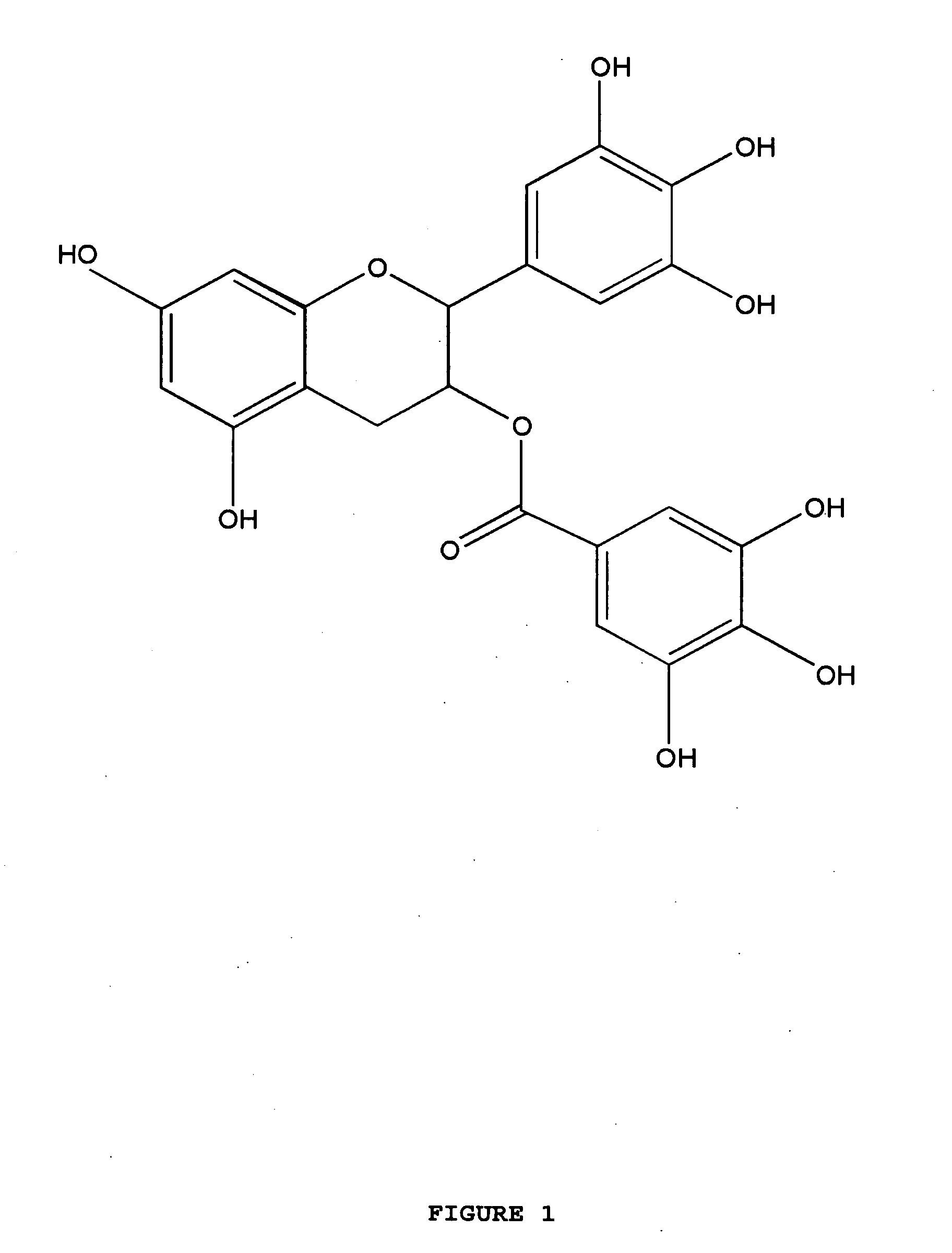Reagents and methods to treat ocular diseases and infection
a technology of ocular diseases and reagents, applied in the field of reagents and methods to treat ocular diseases and infection, can solve the problems of high contagiousness of conjunctivitis, ineffective or poorly effective treatment of viral conjunctivitis, and spread to many students or young children
- Summary
- Abstract
- Description
- Claims
- Application Information
AI Technical Summary
Benefits of technology
Problems solved by technology
Method used
Image
Examples
example i
Activity of EGCG Against Adenovirus In Vitro
[0066]This example describes the activity of EGCG against adenovirus in vitro.
[0067]EGCG is tested for activity against adenovirus in vitro. The activity of a catechin or polyphenol such as EGCG is tested essentially as described previously (Weber et al., Antiviral Res. 58:167-173 (2003), which is incorporated herein by reference). The effect of green tea catechins, and particularly the predominant component, epigallocatechin-3-gallate (EGCG), is tested on adenovirus infection in cell culture. Adding EGCG, for example, 100 microM, to the medium of infected cells is tested for reducing virus yield, IC50 values and therapeutic index. The agents are tested for the most effective time to be added to the cells. The compounds are also tested for inhibitory activity of the viral protease adenain. In the studies described by Weber et al., a concentration of 0.005% was found to be effective in in vitro cultures. The results showed inhibitory effect...
example ii
Animal Model for Treating Adenovirus Ocular Infection
[0080]This example describes animal models suitable for EGCG, other compounds, or combinations of EGCG with other antimicrobial agents.
[0081]Adenovirus is inoculated intrastromally or topically. A non-replicative lacZ adenovirus can be used for a prophylaxis indication to study the mechanism of adenovirus infection. An exemplary animal model for ocular infection is described in Kaneko et al., Antiviral Res. 61:63-66 (2004), which is incorporated herein by reference.
[0082]To determine the antiviral effects of compounds against ocular adenovirus (AdV) infection, an established animal model of adenovirus infection such as cotton rat eyes is used (see Kaneko et al., supra, 2004). Briefly, cotton rat eyes are inoculated intrastromally and topically with adenovirus, for example, any one or combination of the adenovirus serotypes, and treated topically with test compounds in eye drops, for example, twice a day. The infected corneas are e...
example iii
Testing of Anti-Adenoviral Formulations
[0086]This example describes the testing of various formulations of EGCG for anti-adenoviral activity alone or in combination with other antimicrobial agents.
[0087]The efficacy of various formulations of EGCG is tested using human embryonic kidney 293 (HEK 293) cells in plaque assays and viral replication assays. Synergistic activity is tested with combinations of EGCG and one or more antimcirobial agents or antibiotics, including antiviral agents.
[0088]Briefly, HEK 293 cell layers are prepared by cell culture in several 6-well cell culture plates. The cells are incubated at 37° C. with 4-6% CO2 and required humidity to form a complete layer. The media is removed and replaced with fresh media. Viral particles are added with increasing concentrations in five wells and one well is reserved as a control. The plates are incubated overnight and the media is removed the next day. The cells are covered with Agar / growth media solution at the concentrat...
PUM
| Property | Measurement | Unit |
|---|---|---|
| pH | aaaaa | aaaaa |
| pH | aaaaa | aaaaa |
| viscosity | aaaaa | aaaaa |
Abstract
Description
Claims
Application Information
 Login to View More
Login to View More - R&D
- Intellectual Property
- Life Sciences
- Materials
- Tech Scout
- Unparalleled Data Quality
- Higher Quality Content
- 60% Fewer Hallucinations
Browse by: Latest US Patents, China's latest patents, Technical Efficacy Thesaurus, Application Domain, Technology Topic, Popular Technical Reports.
© 2025 PatSnap. All rights reserved.Legal|Privacy policy|Modern Slavery Act Transparency Statement|Sitemap|About US| Contact US: help@patsnap.com


